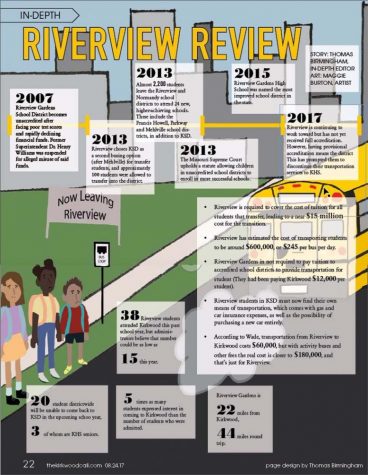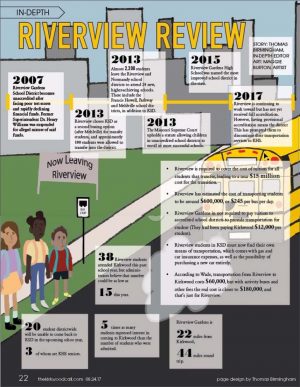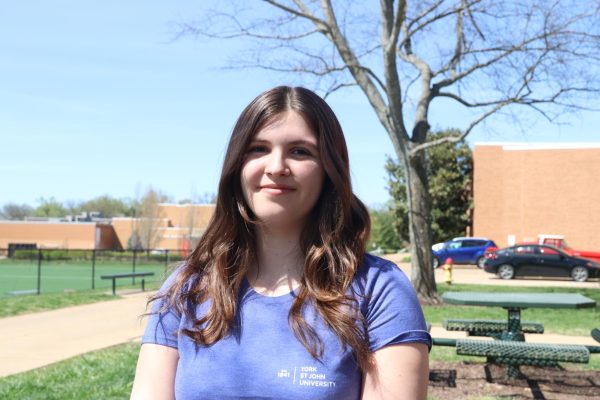‘It comes down to class’
Riverview Gardens School District makes approximately 30 million less dollars in revenue than Kirkwood School District
When KSD students returned to school this August, they came without a group of their peers whom they studied alongside for almost a decade. Riverview Gardens School District students attended KSD from 2013-2022 following RGSD’s falling into state-oversight in 2007.
RGSD lost its accreditation as a result of a low APR score, which the Missouri Department of Elementary and Secondary Education (DESE) calculates and uses to assess which districts are not meeting statewide requirements. Attendance and graduation rates, statewide assessment scores (MAP tests, EOCs) and finances are a few of the categories that the DESE uses to calculate a district’s APR score.
The ruling in Breitenfeld v. Clayton (2013) decided unaccredited school districts are required to provide transportation and pay tuition for students to transfer to an accredited district in the same or neighboring county. More than 1,000 of RGSD’s 5,000 students requested to leave after the decision was announced, according to Dr. Howard Fields, assistant principal of human resources at KHS. RGSD originally chose Mehlville School District, but added KSD when Mehlville ran out of room for additional students. Dr. Mike Havener, KHS principal, said approximately 70-80 students came to KHS in the fall of 2013.
Fields began his career as a physical education teacher at RGSD in 2002 and went on to become principal there. He was entering his second year as assistant principal at Westview Middle School when the decision in Breitenfeld v. Clayton was announced.
“It was difficult seeing many of our kids who we had strong relationships with transfer to a different school district,” Fields said. “Some of the parents and students I spoke with just wanted to access different opportunities that we didn’t necessarily have at RGSD and you have to respect that.”
It was difficult seeing many of our kids who we had strong relationships with transfer to a different school district
— Dr. Fields
RGSD was harmed by the hiring of a new superintendent in 2002, Dr. Henry Williams. During his career at RGSD he illegally mismanaged hundreds of thousands of dollars in school funds to aid himself, as reported by the St. Louis Post-Dispatch. By the time he had been fired in 2007, RGSD had lost its accreditation. He was sent to prison in 2009, where he died three years later. Dr. Lisa Autry was a chemistry teacher in RGSD prior to the 2002-03 school year and is currently principal of KHS’ Discovery Center.
“Although the racial demographic is very different, the root causes [of RGSD’s struggle] are more socioeconomic than they are racial,” said Autry. “There’s less income to pay for things in schools, like school supplies and lab equipment.”
Autry left the district after a year of Williams as superintendent and credits him with many of RGSD’s problems. However, she believes the district would have lost accreditation even without his mismanagement.
North St. Louis County has a much less economically-productive tax base to finance schools than those of Central St. Louis County, where KSD is located. RGSD generates an approximate income of $65.3 million a year to provide education for 5,056 students, whereas KSD generates $92.4 million to educate 6,072 students, according to US News and World Report. This means KSD has around 50% more funding for their students. Fields said state and federal dollars do little to close the gap between the two, and Autry added that state and federal money is often less useful because it comes with “strings attached,” or requirements on what the money can and cannot be spent on.
It comes down to class
— Dr. Fields
“It comes down to class,” said Fields. “The resources are absolutely not the same. There are some challenges that are nearly exclusive to communities of color, to communities with high crime rates, to communities with high poverty rates. When you look at every large metropolitan city, if there’s a lot of poverty and a lot of crime, there’s typically not enough resources.”
While preparing for the upcoming school year in late summer 2013, Havener received word from the KSD superintendent that he would have to make room for an incoming class of almost 80 new students after RGSD had named KSD as a destination district for students who requested to transfer.
“It wasn’t like we had months to figure out what this transition would look like,” said Havener. “Once the decision was made and the students were here, they’re our students. And we just hit the ground running. We should be proud they chose us.”
Your donation will support the student journalists of Kirkwood High School. Your contribution will allow us to purchase equipment and cover our annual website hosting costs.

He/Him
Hobbies and Interests: watching F1, collecting subway maps, watching the Seattle Kraken and drinking Monster
Favorite movie: Inception
Favorite...

He/Him
Hobbies and Interests: I enjoy reading, watching the UCL after school, listening to music at 2 am, consuming TikTok slideshows, and watching...

She/They
Hobbies and Interests: music, art, reading, collages
Favorite song: Mona Lisa by Mxmtoon
Favorite Quote: "We cannot become what we...

















